Duration: 56 days
After refuelling we departed Breakwater Marina Townsville on the 23rd of September initially retracing our route through Townsville waters for an overnight stay at Magnetic Island. Though this trip, we approached the island from the south side. Passenger and car ferries as well as small cargo ships dock at Nelly Bay on this side of the island. Lots of accommodation and resorts here (high rise apartments and cute chalets) as well as a small marina. We continued along the southeast coastline passing Bremner Point with huge rock formations, Alma Bay next door, then Florence and Radical Bays which we saw from the land side on our previous visit here. As we continued motoring towards Horseshoe Bay and with the wind in our favour, we took the opportunity to bring the headsail down. We noticed a hole on the luff a few weeks back which has been getting progressively bigger. So once anchored, and until we can organise a replacement sail, Peter took the opportunity to get his sewing kit out and patched it. Nice job too.

We were up at 0530 to prep for our trip out to Wheelers Cay for some snorkelling. Though very quickly we were being hit by strong 18+ knot winds, and a strong head on chop. By 0900 Peter decided to abandon the trip to Wheelers Cay, as it would not be suitable for snorkelling in these conditions. So, we changed course southward, unfortunately for us the sea and wind conditions continued to be challenging. We passed Cleveland Point and Mount Cleveland before finally anchoring for an overnight stay at ……. Cape Bowling Green in Bowling Green Bay. Where do they get these names!! A long skinny flat sandy cape which stretches in a shallow arc. And to the naked eye it is so flat one could liken it to a bowling green. Strong ESE winds continued overnight, but the anchor held which was the most important thing.
Another early start saw us upping anchor at Bowling Green Bay to face another day of crappy washing machine seas and strong ESE winds (up to 20 knots). Around the top of the Cape conditions didn’t improve, as a 1.5 – 2 metre swell was running, initially head on. It was a long and at times uncomfortable motor-sail, until we finally anchored in Shark Bay at Cape Upstart right in front of huge heavily vegetated hills, just gorgeous. Houses were sporadically clustered in two’s and three’s along this part of the bay. By sunset a number of other boats had joined us in the bay, no doubt taking shelter from the unsettled conditions. We couldn’t resist the temptation to stay here for another night, just a beautiful spot to chill. Photos below of the view from our anchorage, then round the corner looking back on the headland.

 Gloucester Bay
Gloucester Bay
We upped anchor at Shark Bay (Cape Upstart) at 0700, and motor sailed around the headland. Initially low cloud and mist reduced visibility as we crossed Abbot Bay, but by the time we got to the coal loading facility on the other side (Point Abbot), it had cleared. Then passing Bowen, regarded as the capital of north Queensland and surrounded by land rich in minerals, particularly coal. Not a huge coastline presence which was different to other towns we had passed thus far, though Peter who has visited here previously remembered the town being quite spread out. Then it was onto our destination for the next few days, Gloucester Bay. And not just a destination but a celebration as well.
We sailed here from Brisbane in September 2020, and Cape Gloucester was the starting point for our journey south then west to reach Adelaide on 1st January 2021. So, drum roll please ……………
We have officially completed our circumnavigation of the Australian mainland by boat. Yippee!!
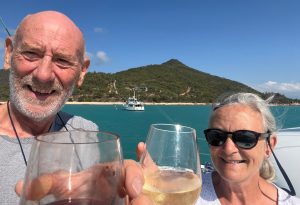
Gloucester Bay sits between Gloucester Island and Cape Gloucester on the mainland. Gloucester Island is the northern most island of the Whitsunday Island group. The Cape is just 60 kms from Airlie Beach, about an hour by car. The beach, two resorts, restaurant and bar are hugely popular for getaways and day trippers. We moored here for three nights and made the most of the beach, facilities and entertainment nearby.
Cape Gloucester Resort has had a few additions since 2020, water slides for the kids and a volleyball area have been added, and there were more shaded palm huts. It was busy, not only was it a weekend but school holidays here as well so there were lots of families making the most of the beach and the pool. (Stinger season doesn’t officially start here until October-November, though we noticed more people were in the pool than the sea). We spent a couple of afternoons at the resort bar and restaurant enjoying the ambience, great muso’s, and amazing cocktails. We didn’t eat here but from what we could see the food looked yummy with generous serves. Camping or chalet type accommodation is located nearby.
We walked the beach as we did in 2020 around the corner to Monte’s Reef Resort. With a view to majestic Gloucester Island and with Shag Islet in the foreground it’s a fabulous setting. And the weather ticked all the boxes as well …… sunshine from sunrise to sunset, blue sky turning to a sparkling night sky, crystal clear water and sandy beaches. Queensland at its best. Photos below of Monte’s Reef Resort and Gloucester Island.


Just a quick introduction to Shag Islet which sits in the bay but very close to the beach. Situated in front of the Cape Gloucester Resort and to the left of Montes Reef Resort, you can walk-wade to the islet at low tide, you could also swim, kayak or paddle board. For those of you unfamiliar with Shag Islet, it is famous for ‘Shaggers’ the loyal members of the Shag Islet Cruising Yacht Club (SICYC), a social network of cruising yachties and individuals who enjoy any form of boating. The yacht club boasts more than 3500 members from 14 countries around the world. All members are registered as ‘Vice Commodores’, each representing an individual nautical location such as an island, islet, river or bay, which they have some knowledge of, so as to be able to provide advice or assistance to other ‘Vice Commodores’ of the club. The club supports the Prostate Cancer Foundation of Australia and to date has raised a significant amount of money to support prostate cancer research. An annual ‘meeting’ of members at the Islet attracts Shaggers from near and far. To join the club or for more information head to www.sicyc.com.au
Following a great three-night stay, we departed our mooring at Gloucester Bay and made our way through Gloucester Channel, a beautiful passageway between the mainland and Gloucester Island. Then passing Hideaway Bay with lots of McMansions dotted up and along the hillside. By late morning we were motor-sailing passed Airlie Beach with the massive cruise liner Carnival Splendor anchored just off shore. (This is the second time we have crossed paths with this cruise ship, the first time was during an overnight sail from Cape York when it was lit up like a Christmas Tree).
We continued on, passing lots of islands to both port and starboard, including Saddleback and Double Islands to reach Hook Island with Hayman Island next door. (Reminded us of the game shows in the 1970’s and 1980’s when the main prize was a holiday to Hayman Island. Well, we are pleased to report that not one but two resorts are now operating there). We motored through Hayman Channel to reach Stonehaven Bay hoping to find a mooring*. Lots of other boats also on the lookout as well. Luckily there were more mooring buoys available than were noted on our chart, so we were lucky this time round.
*These are public moorings installed and maintained by the Queensland Department of Transport. Most popular mooring fields have moorings of different sizes i.e. linked to the size and weight of the boat which is important if strong winds or a storm blows up. Usage is free of charge, and there is a maximum 2 hour, 4 hour or 24 hour time limit. The mooring ball will have a tag attached or label on it denoting the maximum boat size and time limit. An honour system applies. Having said that we have anchored near mooring fields where boats have been on a 24 hour mooring for three days which is fine if there are other moorings available but not fair to other boaties when all moorings are in use.
Hook Island
The view from our boat over Stonehaven Bay to the island was the typically gorgeous vista we have come to love and associate with this part of Australia. Soaring heavily vegetated mountainside with a pristine sandy beach below. Large rock formations sit either side of the beach with a coral reef not far offshore. Coral reefs abound in this part of Queensland, and we were keen to explore not only the coral but the abundant sea life as well. We had read great things about Manta Ray Bay, which wasn’t that far away. There are a couple of 2 hour moorings here but with the number of tourist boats in the area you would have to be super lucky to get one of those. Our other options were moorings next door at Luncheon Bay or Butterfly Bay, a bit further away but doable.
So next morning we departed our mooring at Stonehaven Bay and made our way along The Narrows, a channel which runs between Hayman and Hook Islands. Peter at the helm while Sandra was on the lookout for a mooring. We couldn’t believe our luck, approaching the mooring field at Luncheon Bay there was a free mooring. We were almost there when a monohull from the other direction burned ahead of us and snaffled it! Honestly, we were so disappointed, it’s like missing out on the last car park during the Christmas sales. Sea Goddess is built for endurance not speed, so we were never going to win that race.
Just on the off chance we headed around the corner to Manta Ray Bay but as we expected all the 2 hour moorings were in use, so back we came thinking to go past Luncheon Bay to the next bay over when we noticed two boats were leaving. Brilliant, we managed to get a mooring here after all. Now to get to Manta Ray Bay for some snorkelling and to check out the coral and sea life ……. when the wind whipped up and the sea became quite choppy. We gave it a couple of hours to settle, then with our rashies on and snorkelling gear in the tender we made our way back to Manta Ray Bay. Wow it was crowded with snorkellers from three tourist boats already in the water, plus people from two catamarans and a monohull yacht. Did we mention it’s a small, sheltered bay? Our solution was to flip the timing of our activities. Snorkel in Luncheon Bay today then come back to Manta Ray Bay early tomorrow before the tourist boats arrived from Airlie Beach. Best idea, as both of these snorkelling sessions were fabulous. Photos below of gigantic rocks at Luncheon Bay, and who knew starfish could be blue. Photo taken on GoPro while snorkelling in Luncheon bay.


Similar to other islands we have visited, the beaches and shallows of both bays were a mass of dead coral, but once past the shallows a whole underwater world opened up. Coral of all types, shapes, textures and colours …. the peach, yellow and mauve were Sandra’s favourites. We didn’t see many fish at Luncheon Bay, but they were aplenty at Manta Ray Bay – coral trout, parrotfish, anemone fish, and lots of others which we couldn’t identify. It was like being ‘IN’ an aquarium, amazing. (No Manta Ray’s though).


The next morning, we moved one bay over to Butterfly Bay. The way the bay is shaped with a long central rock formation gave the bay a McDonald’s M formation, so with a lot of poetic licence we could see how the name came about. One of the things we like to do is take our dinghy around the perimeter of each bay that we anchor or moor in. Each one is different – there may be a beach; rock formations; underwater or exposed reefs; coral, or mangroves, flowering shrubs, and trees. Mother Nature is always very generous and beautiful. Photo below: amazing ‘clam’ rock formation at Butterfly Bay.

By afternoon the mooring buoy was consistently hitting the hull, sometimes very loudly which was concerning as to any damage or indentation occurring to the hull. We tried to shorten the lines, thinking that might reduce this but it didn’t make any difference. As he does each afternoon, Peter checked the weather and strong winds were forecast for the next couple of days, so we decided to leave this mooring and move back to the protection of Stonehaven Bay. Well, it was a race between us and two other catamarans, actually it was more like the tortoise and the hares. Luckily there were enough available moorings for everyone including us, and by maintaining our tortoise tag we saved a bucket of fuel.
It was a wild night with super strong winds and even stronger gusts. And we experienced our first lot of rain in a long time, which we were actually very grateful for as it washed the salt off our decks and windows. We also moved moorings, which is permissible and resets the 24 hour clock. In the afternoon the weather settled so we took the dinghy over to the beach area with a number of amazing onshore rock formations (photo below). Unfortunately, there were also dreaded midges around who just loved Sandra, ugh! Photo: More amazing rock formations, this time at Stonehaven Bay Hook Island.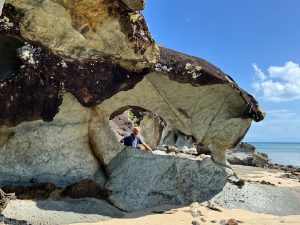
We left the mooring at Stonehaven Bay on a warm sunny, blue sky morning, and once again retraced our steps through The Narrows between Hook and Hayman Islands, passing Butterfly, Luncheon and Manta Ray Bays, then the rocky outcrops of Pinnacle Point. This next phase of our journey south will see us visiting several islands for 1 – 2 night stops until we reach Mackay.
Whitsunday Island
We motor-sailed along the seaside of Hook Island, as opposed to the bay side, then further south between Whitsunday Island and the aptly named Dumbell Island until we reached Apostle Bay. A beautifully sheltered and tranquil V shaped bay surrounded on both sides by heavily vegetated hills. A haven for turtles, the shiest of sea life, we saw four pop up to check us out in a couple of hours. Sitting in the cockpit with a wine, the only thing interrupting the silence is the occasional bird call. Just magic.
Next morning we headed round the corner to Tongue Bay, a highly popular spot for cruisers, charter boats and high speed tourist boats. We were super lucky to score a 24 hour mooring and once we were settled it was time to explore. The small beach area led to a path with two options – beach or lookout. We decided to take the lookout route first and weren’t disappointed. The easy upward stepped trail led to a lookout with stunning panoramic views over the waters surrounding Whitsunday Island including the nearby islands of Esk and Petrel right round to Whitehaven Beach where we had anchored in 2020. Back down the trail we took the other path which led to a boardwalk and Betty’s Beach. A large silica sand beach, so white you needed sunglasses just to walk on it, which then led to the clearest water we have ever seen. The beach was very busy with swimmers and sunbathers, and with the tide out it was safe for all ages and swimming levels. We hadn’t brought our bathers, so we were happy to walk through the shallows this visit, though we returned the next day for a swim. With amazing views like these its no wonder the islands of North Queensland are a haven for tourists and locals alike.
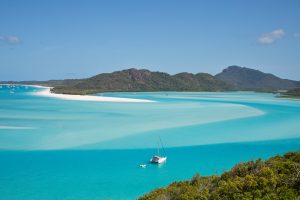

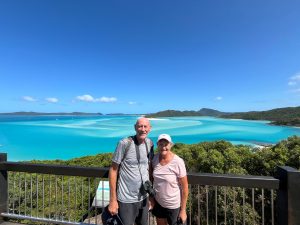
Haslewood Island
Haslewood sits ocean side of Whitsunday Island, so it was only a short hop under motor to get there. (In the photo above, you can just see it to the left of Peter in the background). This side of the island is a well-known snorkelling spot, with a number of snorkellers already in the water when we arrived. Well, it didn’t disappoint. There were several large coral reef patches with fish darting here and there. The water was so clear, and a perfect temperature for meandering around.
Lindeman Island
We set off the next morning for more island hopping down the Queensland coast. But first we had to make our way through strong tidal turbulence near Martin Islet which sits near the southernmost part of Haslewood Island. From here we turned southwards and made our way between the Islet and Whitsunday Island (Solway Channel) heading for Lindeman Island. An easy three-hour motor sail, passing a gorgeous island called Pentecost with the most magnificent soaring rock formation which can be seen for miles (Mount Pentecost). Then the Anchor Islands and Sir James Smith Island group, before making our way along the channel between Lindeman and Shaw Islands. Photo of Pentecost Island with Mount Pentecost rising skyward.

We anchored at Lindeman Island, then after lunch took the dinghy along the heavily vegetated and rocky island coastline to the Lindeman Island resort. Like the resort at Dunk Island, this one was also pummelled by Cyclone Yasi in 2011. The ruined buildings are still standing, though they are in much better shape than those of Dunk Island. Access to this part of the island is not permitted, but we could see that at least a couple of the villas were lived in. In fact, a bloke came out of one and gave us a wave, we assumed he was a caretaker. A Google search brought us up to speed on what the current state of play is here. Last year the island was sold to a Singaporean company, after plans by the previous Chinese owners stalled. However, we couldn’t find any information regarding future plans for the island or the resort. Guess it’ll remain as is for a while longer.

Next morning around 0500 we were woken to the distant sound of thunder and not long after we were in the middle of a massive thunderstorm with pelting rain and 30+ knot winds. Our first thoughts were to the anchor, and whether it was holding. Luckily for us it was doing its job, we were moving in an arc but holding. Unfortunately, the large monohull next to us had dragged, you could see the disturbance in the water where their anchor had dislodged. The boat was swinging uncontrollably, at times its stern coming towards Sea Goddess. Peter was up at the helm getting ready to start the engines and get us away from them, Sandra was getting ready to retrieve our anchor. Those on board the monohull were hanging in there, trying to manage the situation. In the end they brought their anchor up and moved on. Phew! It was certainly scary, and we’re not just talking about the storm which continued to rage around us for over an hour. By 0700 the main cell had passed – rain eased, the sea state calmed, though we were still experiencing the occasional strong gust of wind. Well, that was interesting start to the day, who says sailing is boring!

Thomas Island
We left later that morning for another overnight stop at Thomas Island. Part of the Lindeman Island Group, this island is owned and managed by Queensland National Parks. We anchored in the sheltered and protected channel between Thomas and Long Islands and were immediately visited by a turtle, checking us out as it swam by. We took the dinghy for a trip around the shoreline and got off for a walk along the beach. Found the National Park sign and trail leading to the top of the highest point, but we gave it a miss as we were concerned about the possibility of more midge bites and ticks. A nice beach made way for lush tropical plants and trees. Bush turkeys gobbling, to let their mates know we were around. Peter found what looked to be the remains of a garden then a fence, some metal pipes and slabs of asphalt. Not sure what that was all about, quite possibly another casualty of Cyclone Yasi, but definitely some sort of structure was here in the past. Four people from a couple of other anchored boats were on the beach. They’ve been here since we arrived this morning and by the looks of them, they haven’t heard of the sun safe message. Back on board for sundowners and finalising our plans for the next few days. At this stage overnighters at Brampton and St Bees Islands with a longer stay at the Mackay Port Marina. Spotted another three turtles, problem is we’re not sure if it’s just the same one swimming around. Ha Ha!
Brampton Island
Sailing conditions weren’t great for our move to Brampton, washing machine seas and the wind was a bit all over the place. We motor-sailed with the main and jib out, seas settled around 9-ish. Closer to our destination we passed the Finger and Thumb Islands and Coffin Island, great names, before anchoring in Maryport Bay Brampton Island.
After lunch we took the dinghy along the coastline to the ruins of the resort. Like Dunk and Lindeman, the resort here was also destroyed, in this case not by one but two cyclones, Yasi then Debbie. We could see the remains of the jetty where day trippers and guests would be ferried from Mackay, and a railway line which ran alongside a man made sea wall to the resort. Similar to the Lindeman resort the external walls and roofs of buildings here are in pretty good shape. However, we understand the water and electrical infrastructure, generator, staff quarters and pool area were severely damaged. A caretaker lives on the island to prevent looting and to maintain what’s left. Then it was time for sundowners. Sharing our journeys and plans, swapping tips and ideas while sipping wine with the owners of Rubicon and Mad Fish who were anchored nearby. Photo below shows part of the resort as is. Behind the rocks in the foreground is the remains of one of the outdoor swimming pools.

We upped anchor at 0815 bound for a mooring at St Bee’s Island, a trip of about 11 nautical miles. Seas were rough from the get go, ESE winds 16-18 knots with gusts much higher, so the initial hoisting of the mainsail was particularly stressful in the conditions. We made our way southwards passing Edgell Rock which had the uncanny appearance of a lion lying proudly on a plinth, with Maryport Island behind.

Scawfell Island
Sea and wind conditions continued to be challenging until we entered Egremont Passage, the channel which runs between St Bees Island and Keswick Island. Unfortunately, when we arrived at the end of the channel the one remaining mooring was not of a suitable capacity for the length and weight of Sea Goddess. So where to now? We needed to find shelter from strong winds predicted to arrive later that night and continue for 48 hours. One thing about Peter, he always has a Plan B and C up his sleeve. So, we backtracked along the channel into open waters and headed east to Scawfell Island. This would take us away from Mackay, our next destination, but was the safest option as we could reach here in daylight and there are multiple moorings available here. Again, we were unlucky here. Every mooring was taken so we anchored in the lee of the island at Refuge Bay. Due to the height of the island and by getting in close to shore, we had reasonable protection from the wind. The Anchor Watch app will also be invaluable here, particularly overnight when we try to get some rest.
Well, we woke up to a grey, windy morning and when the rain fell it was full on. The anchor held overnight with no issues, so we’ll stay put for today and tonight as well. We spent the day chilling on the boat, and as afternoon turned to evening the winds picked up big time. This continued throughout the night, and we were woken several times with the wind howling and gusting 30+ knots. We checked the anchor watch app regularly to a) ensure it was still working and b) to see where we were in relation to the anchor. We were swinging a lot which was to be expected but the anchor held which was great.
Next day any thoughts of departing for Mackay were dashed due to continuing strong winds and unfavourable seas. Whilst things weren’t necessarily calm in Refuge Bay the waters within the bay were manageable and the surrounding hills provided some shelter from the strong winds which were expected to continue until tomorrow morning. We had a better sleep overnight, not as blustery or rocky.
We were up around 0515 to prep for our trip to Mackay, upping anchor at 0600. We put the mainsail up and headsail out while we were still in Refuge Bay. Once we cleared the bay the sails did their job, and whilst the seas were choppy, we were making good progress. Around mid-morning we heard a massive bang, and the mainsail dropped inexplicably. Initially we thought the halyard had snapped, but it was actually the halyard block. What a mess, there was white Dacron all over the helm station and cockpit roofs. We were in a right pickle as the wind didn’t stop, the waves kept coming and we had to maintain our course. Sandra provided overwatch at the helm, Peter got his lifejacket on and with both engines at 1300rpm he attempted to get the mainsail back into the sail bag, but it was just too heavy. So, he changed his approach and used the spinnaker halyard to raise the mainsail to a point where he could manage the sail and the battens; and flake the sail into the sail bag. Not pretty but we got it done!
That wasn’t the only challenge today. We arrived at the marina and the berth we had been allocated already had a catamaran docked there. The remaining space probably would have suited a very small monohull, way too narrow for Sea Goddess. We reversed out of the fairway and headed back towards the marina entrance. As this is happening, Peter called the marina office and got a new berth allocation. We made a U-turn and went back around for another go. As we came around, the newly allocated berth was on the port side, we had set up lines and fenders for starboard side. With three neighbours on the dock waiting to help us, it was a scramble to get everything changed over. In the end we just did what was necessary and finessed it after we had docked. Once all our post sail jobs were completed, Peter went up to the office and came back with a marina welcome bag and a bottle of wine. What a day! It was an early night, and we both slept blissfully to the sound of nothing.
Mackay
We spent two weeks here waiting for spare parts to arrive as well as completing a myriad of maintenance and cleaning jobs. But it wasn’t all work, we were out and about most days taking the opportunity to check out this regional city. Getting around on our ebikes was super easy via the designated pedestrian and bicycle clearway which started from the end of the breakwater, meandered its way southward along Harbour Road, crossed over the Pioneer River to the CBD. (About 7.5 kms each way). A similar path followed the river to a large modern shopping centre, Caneland, a nod to the sugar cane industry which actively operates within the region. For those Adelaideans reading this blog Caneland is about the size of West Lakes.
Each time we headed into town we passed a weatherboard building which housed ‘Kitten Vintage’ offering Devonshire tea, antiques and paraphernalia. Sandra couldn’t resist, and in we went one morning. Each room was busting to its limits with ‘stuff’, it was fabulous as was the morning tea. We left with four martini style glasses, perfect for Friday night cocktails when we move back to Adelaide.
One Saturday afternoon, we left the bikes near the river bridge, and walked along Sydney Street, the main thoroughfare in and out of the city. Similar to Townsville, a number of shops and businesses had closed down. The buildings, from bygone days, were just lovely. Of particular interest to Sandra was the number of Art Deco buildings, a style of architecture and décor which she loves. We just hope they survive. We then left the CBD and walked to Queens Park which showcased the flora of the region and north Queensland.

And then there was this ….. walking along the dock we noticed two guys looking in the water. Curious, we asked what they were looking at. And then slowly these gorgeous manta rays appeared, amazing!

Apologies for the picture quality, we grabbed this from a video. There were about 10 – 12 in all.
As we continue south, and in light of our decision to end our journey at the Gold Coast we look forward to visiting some new destinations and revisiting some of our favourites.
Middle Island
We left Mackay Marina at 0915 and motored through Hay Point anchorage where 18 cargo ships were waiting to get loaded up with coal. Got quite close to a couple. Then onto Prudhoe Island with a plan to anchor here, but we quickly changed our minds. Firstly, we weren’t happy with the undulating sea floor and the large rocks under the surface which could impede anchor retrieval. And we were already being buffeted by strong wind gusts coming directly at us though valley. Decision made, we backed out and continued southwards. Not optimal as it will mean an overnight sail and most likely we will miss stopping at a couple of islands, but this wasn’t a safe anchorage and anchoring in the dark elsewhere was not an option.

First stop was Middle Island, part of the Percy Island Group and one of our favourite places to visit. Our last visit here was in 2020, and we anchored in almost the same spot at West Bay. We are pleased to report that the charm of this island has remained the same. We took our dinghy over to the island to reacquaint ourselves with the famous ‘Percy Island Yacht Club’ a wooden A frame structure filled with signs and paraphernalia of visiting yachts, some stretching back to the early 1950’s. This time we added to the collection. Peter made a small wooden plaque inscribed with ‘Sea Goddess 2020 & 2024 Sandra & Peter’, given this will be our last voyage the moment was really significant for both of us.

Just a short walk away is the ‘phone’ hut where you will find a collection of books which can be ‘borrowed’ and/or you can add to the collection if you have any books on hand to donate. Coconut palms are scattered along the beachfront, each encircled by whole coconut pods that people have taken the time to place there. Walking trails leading to the homestead or to the highest point of the island, are easily located by rock lined trails. Photo below of Peter in front of the Percy Island Yacht Club, a place which holds special meaning for us and boaties who have and continue to visit here.

Great Keppel Island
We left Middle Island mid morning for an overnight sail to Great Keppel Island. Arriving around lunchtime the next day, we anchored on the southern side of the island to gain as much protection as we could from the strong north – north westerly wind. The other members of the boating fraternity had the same idea, as such it was a very busy spot with boats of all shapes and sizes here. A large tourist boat with a group of high school students kept us entertained as several of them clutched onto a large net that was floating behind in the water while the skipper moved the boat this way and that. We could tell when someone lost their grip as there was much whooping and hollering from those watching from the upper stern deck. A dinghy was on hand to fish whoever it was out of the drink and got him or her back onboard via the transom to much cheering and ribbing. Oh, to be young again!
Overnight wind gusts were just crazy, and with a predicted change in wind and swell direction we needed to move and re-anchor on the other side of the island, nestling at Monkey Bay. A small, sheltered bay surrounded by tree and shrub covered slopes that descend into craggy rocks, and a white sandy beach which stretches along most of the bay. Just lovely. People were making the most of the weather and the water with a ‘Learn To Dive’ boat nearby; swimming; paddleboarding and kayaking. Taking the dinghy across the bay we headed one more bay over to the main beach and resort area.
Like a number of other islands, Great Keppel has had its fair share of highs and lows. In its 1980’s heyday, Great Keppel Island Resort was THE place to go in this part of Queensland, a thriving holiday destination with a ‘party’ reputation. Then the resort closed in 2008 due to the global financial crisis and two tropical cyclones hit the island, Cyclone Marcia in 2015 and Cyclone Debbie in 2017. As we walked along the main beach several buildings in various states of disrepair, were still in place. For all its unlucky history the island remains incredibly popular. During our short time here, there were lots of families, anglers, boaties and the like making the most of the sun, sand and stunning crystal-clear waters.
Making our way northwards along the main beach we arrived at the Hideaway Bar and Bistro which was busy with the lunch crowd. The Hideaway Resort, a series of accommodation cabins sits behind here along with another gorgeous and popular beach (the perfectly named Hideaway Beach, as it is tucked away around the corner out of sight of the main beach area). We came back to the bar the next afternoon, unfortunately no muso but they had a great playlist, so we kicked back and had a couple of drinks on the deck. We could get used to this . PS Freedom Fast Cats operate ferries out of Rosslyn Bay near Yeppoon, with daily transits to and from Great Keppel Island.
Lady Musgrave Island
A visit here has been on our bucket list for a long, long time and we were both super excited to finally experience the stunning beauty of this iconic part of the Great Barrier Reef. Crystal clear sea green water -check; azure blue sky – check; coral reefs – check, sun kissed sandy beach, black tip sharks, turtles and turtle nests, abundant bird life – check, check, check. This island and its surrounding waters had it all.
After an overnight sail from Great Keppel Island, we arrived in the vicinity of Lady Musgrave around 0930, just before the peak of high tide, and we could see at least 18 boats anchored or moored near the island, along with a couple of glass bottom boats and a permanent floating dock-accommodation structure. We were also monitoring a power cat, ‘Reef Empress’, making its way towards the island from the mainland. We drifted and watched its path through the narrow entrance channel until it docked at the floating structure. This gave Peter a visual of the safest route to enter the lagoon. Even at high tide the channel was really narrow but we got through with no issues. All the moorings were already in use, so we found an anchorage spot away from any coral bombies or outcrops. (We didn’t want the anchor or anchor chain to get caught). We waited for low tide before taking the dinghy over to the island and surrounds to scope out possible snorkelling spots for tomorrow.
The island and the lagoon are surrounded by a fringing reef, with the island located on the northwestern side of the reef. There are also horizontally layered rock outcrops on the western side of the island, with the rest of the island being mostly sand. So, we took the opportunity to complete a circular island walk checking out both the shallows and the island beach.
- First stop, over to a rock reef wall to see white tip sharks swimming around. We counted eight while we were there, swimming up and down on the lookout for small fish and crustaceans. Best part, these sharks are not aggressive. See video below.
- As we walked around the island we were being encircled and bombed by a variety of different birds as it was nesting and chick season, and they were in protective mode.
- Further on we saw four large turtles swimming up and down in the shallows, which made sense when further on we found multiple tracks leading from the water to several nests in the sand. They were obviously waiting for night fall to lay their eggs. It is nesting season for turtles as well, and the hatchlings will scramble to the sea during January and February.
- We passed the light tower on which the safety light is mounted alerting mariners to the location of the island, then further on to a large camp site.
- Spotted two hawks or eagles circling overhead being chased by several birds in full protection mode of their eggs and chicks.
Snorkelling is best amongst the large coral patches and coral bombies located within the lagoon in deeper water some 50 – 300 metres offshore of the island.
Lady Musgrave Island is only accessible by boat, so if you and yours are looking to head out for a visit or to camp here ferries depart at least daily from both Bundaberg and 1770.
The Last Leg
The final days of this mammoth adventure will be quite nostalgic as we revisit some of our old haunts, first up Moreton Bay. Following our maiden voyage from France we lived aboard Sea Goddess at the Royal Queensland Yacht Squadron for twelve months (mid December 2019 – mid December 2020). Moreton Bay was essentially our back yard during that time and we spent many a weekend sailing and exploring the seaways and islands that make up this gorgeous part of south east Queensland.
Bribie Island
It was a nonstop 49-hour trip from Lady Musgrave to Bribie Island. During Night 2 we were passing the towns and landmarks along the Sunshine Coast – Noosa, the Glass House Mountains, Mooloolaba (where we lived for five years), and Caloundra. For a time, we closely followed the boundary of the Port of Brisbane shipping lane. (By doing so we would avoid any known hazards whilst not impeding the transit of large vessels). In the early hours of the morning, we were in awe as the P&O cruise liner, Pacific Encounter, with all lights ablaze passed us by with about 300 metres to spare. Just amazing.

By sunrise we were motoring along the eastern side of the Bribie coastline before turning at the headland to enter Pumicestone Passage and anchoring just past the Bongaree Jetty. We have always enjoyed our visits here, there is a lovely seaside meets country vibe. Being a weekend the esplanade, beach, jetty and boat ramp were very busy. The Sunday morning markets on the foreshore had a good number and range of stalls. And we enjoyed having a browse before strolling along the esplanade.
Post dinner, we were enjoying a replay of the Edinburgh Military Tattoo on the television when a particularly nasty thunderstorm let loose. Thunder, sheet and fork lightening, heavy rain, strong wind gusts, churning waves and Sea Goddess was bobbing around like a cork in the ocean. One minute the jetty was behind us, the next it was in front of us. Kids, who were having a ball jetty jumping ten minutes ago, were diving for cover. It went on and on for a good hour and a half before the worst of it was over. We were extremely fortunate that our anchor held throughout, and all our onboard electronics were unaffected. However, it took us an hour or two for the adrenaline to settle!
North Stradbroke Island
We departed Bribie the next morning reaching Deanbilla Bay, on the Moreton Bay side vis a vis the Coral Sea side of the island late in the afternoon. The island itself is huge and much of it is uninhabited. Dunwich, though small, is the main town on the island. We have visited here before and apart from more houses on the hillside above the town not much has changed.
With a former leper colony, Benevolent Asylum and old military sites the town has an interesting history. There is also a museum housed in original and replica asylum buildings that you can visit. The museum has a raft of documents and paraphernalia related to the island’s indigenous heritage and community, its colonial history, the leper colony, the asylum, shipwrecks and so on. We were both particularly saddened by a number of unmarked graves which are located just next to the ferry terminal, a stark reminder of how harsh living conditions would have been here in the late 1800’s – early 1900’s. On a cheerier note, there is also an art gallery dedicated to local indigenous art, a craft shop and grocery store in town. We haven’t visited the Little Ship Club which sits to the left of the ferry terminal, but we do know anyone can head in there for a meal and/or a drink.
Perrys Hole near Crusoe Island
On the 13th November we left North Stradbroke Island in totally calm conditions and followed the island coastline passing Goat and Lamb Islands to starboard, before turning to port and entering Canaipa Passage. This passage runs between North Stradbroke Island and Russell Island, and as per our previous voyage in 2021 it required us to manoeuvre Sea Goddess under electrical power lines. A tricky process requiring enormous skill. With Peter hand steering and perfect timing, low tide and only slight sea conditions, we slowly motored as close as we could to the port side bank traversing underneath the highest point of the lines that we could. Phew, we got through to the other side with no problems.(Photo taken from the stern of Sea Goddess).

Moving on along the passage things continued to be tricky. Over time tidal movement had caused sand and sand banks to shift so the channel depth notations and placement of sand bars on our electronic charts were incorrect, plus the current was not in our favour. This required Peter to hand steer and be particularly vigilant for the entire length of our passage.
By 1500 winds had picked up and we could see clouds building. With thunderstorms predicted for this evening we needed to anchor before dusk. Our previous anchorage spots were unsuitable due to the wind direction, so we decided to keep going. While Peter was dealing with the route and conditions at the helm, Sandra checked the saloon chart for possible anchorages and spotted Perrys Hole next to Crusoe Island. An ideal spot as it would provide the protection we needed from strong current and wind gusts. When we arrived, a catamaran and a small trawler were already anchored with just enough room for us to anchor safely with enough swing room.

After dinner, around 7-ish, the predicted super storm cell came through. Black clouds, rain, thunder and once again the scariest part, sheet and fork lightening. It lasted for about an hour, and it was the longest hour it just went on and on. We were so grateful when it moved eastwards with no damage to the boat. Then came the midges and the mozzies, not unexpected since we were surrounded by mangroves. We had the lights off during the storm so we couldn’t see them, but we could feel them, and they were feasting on both of us. By the time we went to bed there was a whole crowd of mozzies waiting for us in our cabin. It was us or them, we won!
We spent another day and night at Perrys Hole before heading south via the main channel to the Gold Coast. We took a similar route to that of 2021- around Jumping Pin Corner, then followed the coastline of South Stradbroke Island, passing the entrance to Coomera River till we reached million dollar mansion row on the waterway. We anchored in The Broadwater at Currigee, South Stradbroke Island. The island at this point is quite narrow with the ocean only a short walk through the scrub. So close we can hear the ocean waves breaking from the cockpit.
Our last weekend on water has come around quickly. On Monday Sea Goddess will be hauled out so we can begin to ready her for sale. It is with mixed emotions that this adventure and chapter of our life ends. Sandra’s Mum often said, ‘One door closes and another opens’. With this in mind, we look forward to resettling in South Australia and creating a new story. A huge thank you to our family and friends who have supported us over the last five and a half years, we couldn’t have done it without you. Smiles and hugs to you all xx
Travel not to find yourself but to remember who you have been along the way.





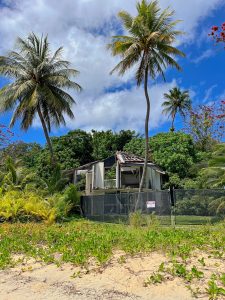
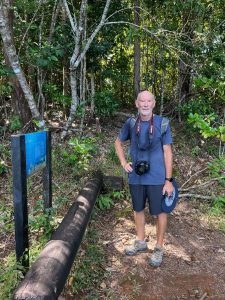



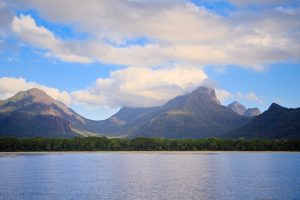

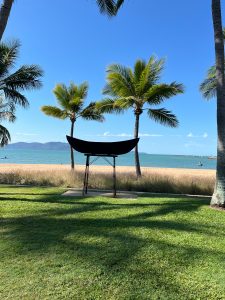

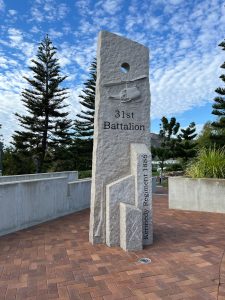



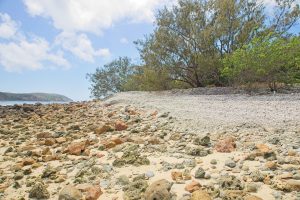



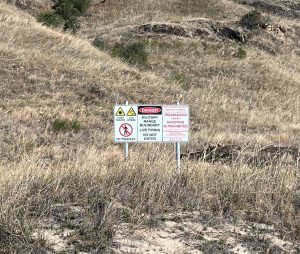


















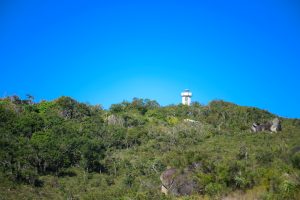
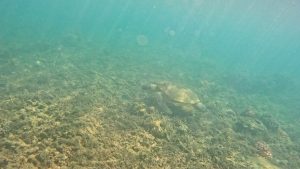
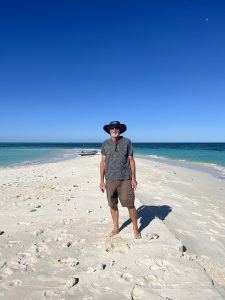


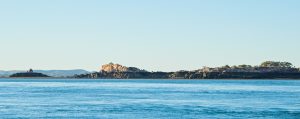
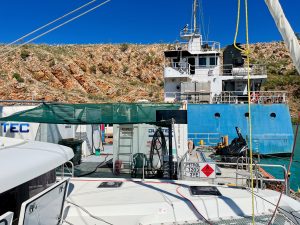
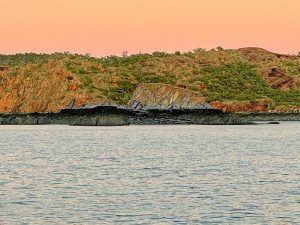
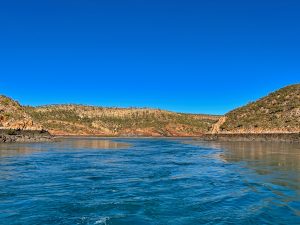
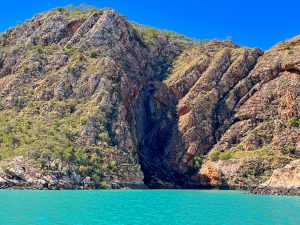
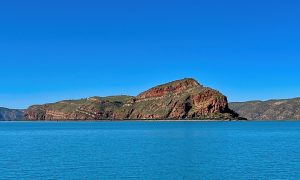
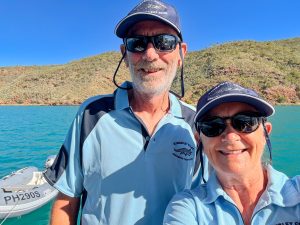
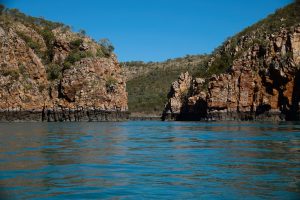
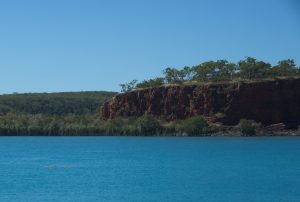

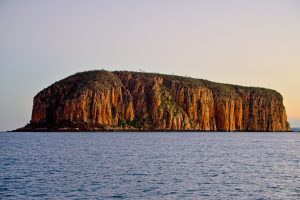
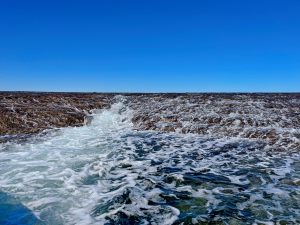
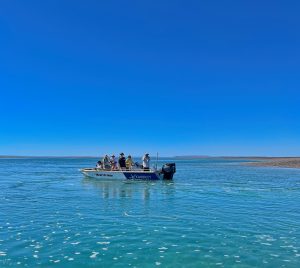
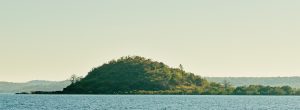

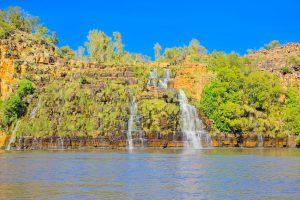

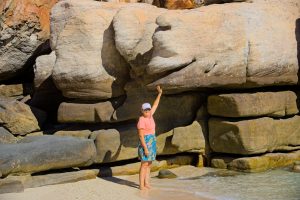
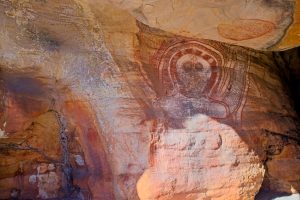
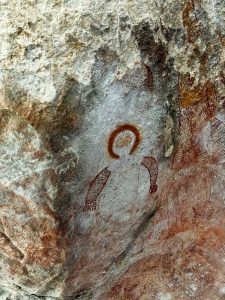

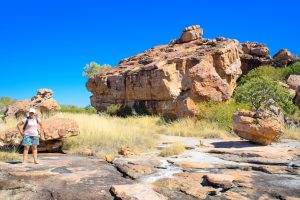
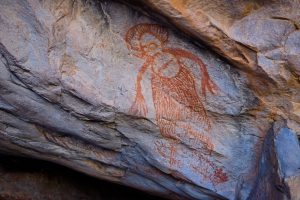
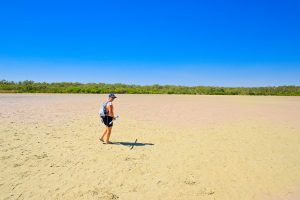
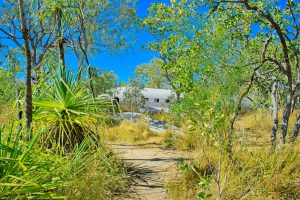
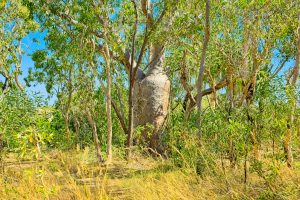
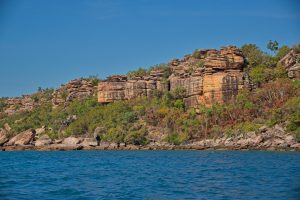
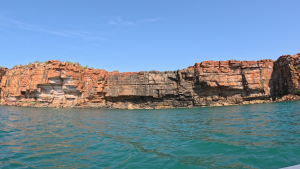
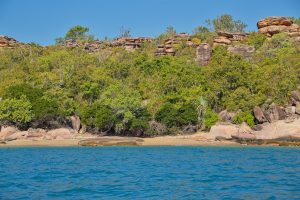
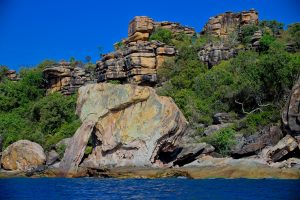
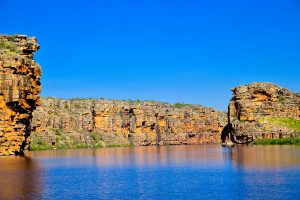

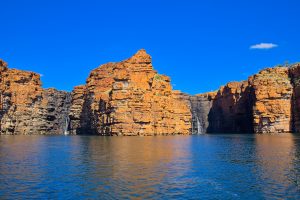
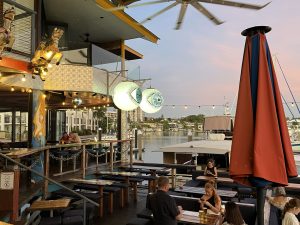










 After a pleasant six-and-a-half-hour sail, joined by the local dolphins along the way, we anchored in the bay near the jetty. Monkey Mia isn’t a town per se, it is a national park with a resort offering various styles of accommodation including a caravan park as well as a modern coastal themed bar/restaurant; a shop with a limited range of groceries, drinks and gifts; park and excursion booking office; a popular boat ramp and jetty, as well as staff offices and quarters. A long, gorgeous beach in front makes way to crystal clear water, just idyllic really. We made our way to the office to pay the required national park fees, $30.00 per adult per day, $10.00 per day for seniors and concession card holders which was quite reasonable. This fee included access to all facilities including the pool, restaurant and so on as well as unlimited attendance at the ‘dolphin experience’ which occurred three times each morning. There were also several commercial operators offering sunset sails, fishing charters and the like.
After a pleasant six-and-a-half-hour sail, joined by the local dolphins along the way, we anchored in the bay near the jetty. Monkey Mia isn’t a town per se, it is a national park with a resort offering various styles of accommodation including a caravan park as well as a modern coastal themed bar/restaurant; a shop with a limited range of groceries, drinks and gifts; park and excursion booking office; a popular boat ramp and jetty, as well as staff offices and quarters. A long, gorgeous beach in front makes way to crystal clear water, just idyllic really. We made our way to the office to pay the required national park fees, $30.00 per adult per day, $10.00 per day for seniors and concession card holders which was quite reasonable. This fee included access to all facilities including the pool, restaurant and so on as well as unlimited attendance at the ‘dolphin experience’ which occurred three times each morning. There were also several commercial operators offering sunset sails, fishing charters and the like.







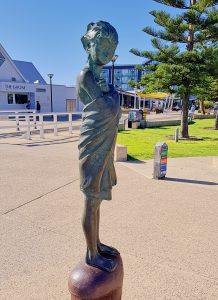
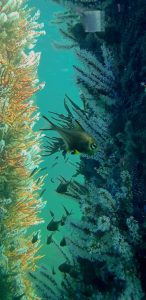 This trip is not just about getting from A to B, but enjoying the journey along the way as well. When there is an opportunity
This trip is not just about getting from A to B, but enjoying the journey along the way as well. When there is an opportunity 



 Next day we took the dinghy to the main jetty, then walked from here around the town to get our bearings and some badly needed food supplies. (We had been here before to drop off and pick up the freezer but that was quite a distance away from our current location). Google maps has been pretty good thus far, and we found the local shopping centre with no issues. Back to the marina by taxi with bags of food ($14.00 fare for those who may be interested). Back on board we both got tizzied up (well as much as you can when you have to climb on and off a dinghy and traverse choppy sea water) for our wedding anniversary dinner. Went to the Cruising Yacht Club on the sea front where we had a lovely meal and were entertained by a great singer.
Next day we took the dinghy to the main jetty, then walked from here around the town to get our bearings and some badly needed food supplies. (We had been here before to drop off and pick up the freezer but that was quite a distance away from our current location). Google maps has been pretty good thus far, and we found the local shopping centre with no issues. Back to the marina by taxi with bags of food ($14.00 fare for those who may be interested). Back on board we both got tizzied up (well as much as you can when you have to climb on and off a dinghy and traverse choppy sea water) for our wedding anniversary dinner. Went to the Cruising Yacht Club on the sea front where we had a lovely meal and were entertained by a great singer.




 Next morning, we headed left this time taking the dinghy to the beach adjacent to Amity Groyne. As a bonus we watched a number of tandem skydivers safely land on Amity Beach, so cool. Then using one of the tourist maps we followed a road to the disused Kingstown Railway Station and Kingstown Barracks which are now used for backpackers accommodation.
Next morning, we headed left this time taking the dinghy to the beach adjacent to Amity Groyne. As a bonus we watched a number of tandem skydivers safely land on Amity Beach, so cool. Then using one of the tourist maps we followed a road to the disused Kingstown Railway Station and Kingstown Barracks which are now used for backpackers accommodation. 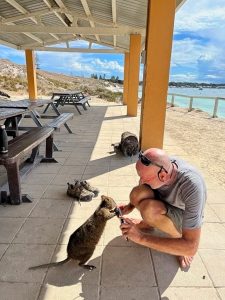




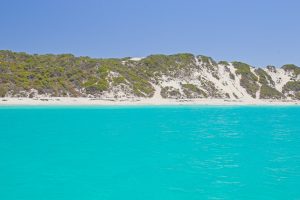

 The next day we headed left from the marina passing the Entertainment Centre following the shoreline of Hanover Bay to the well-maintained Anzac Peace Park. Signage throughout the park provided an account of Albany’s role in transporting troops in both World War I and II. Further on we reached a full-scale replica of the brig named ‘Amity’ which we were able to board and chat with the volunteer about its history. A short walk then brought us to some of the original buildings and houses from the 1800’s, as well as the Museum of the Great Southern. Peter also checked out refrigeration mechanics, unfortunately there weren’t any mechanics who repaired our brand of freezer in the local area. So we decided to make the most of our time here by organising a hire car for three days to travel beyond the town limits.
The next day we headed left from the marina passing the Entertainment Centre following the shoreline of Hanover Bay to the well-maintained Anzac Peace Park. Signage throughout the park provided an account of Albany’s role in transporting troops in both World War I and II. Further on we reached a full-scale replica of the brig named ‘Amity’ which we were able to board and chat with the volunteer about its history. A short walk then brought us to some of the original buildings and houses from the 1800’s, as well as the Museum of the Great Southern. Peter also checked out refrigeration mechanics, unfortunately there weren’t any mechanics who repaired our brand of freezer in the local area. So we decided to make the most of our time here by organising a hire car for three days to travel beyond the town limits.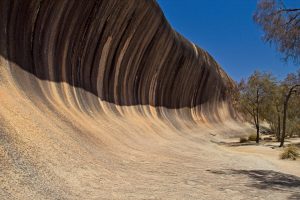



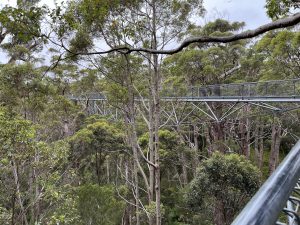
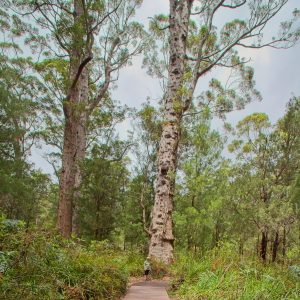
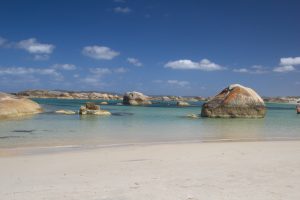
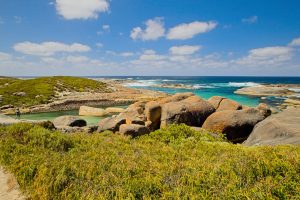


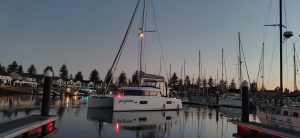
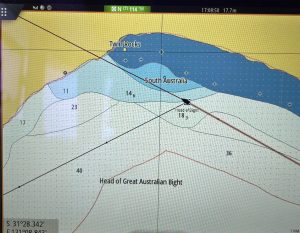


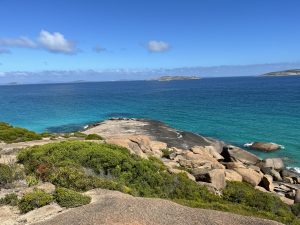

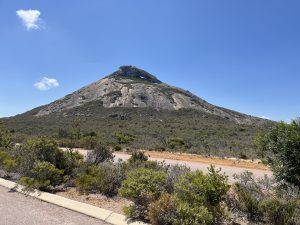
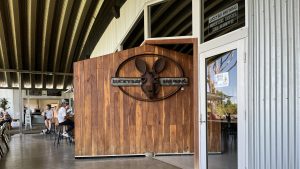
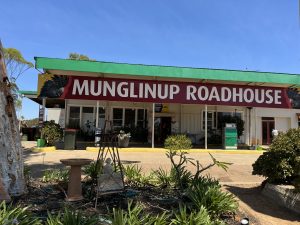
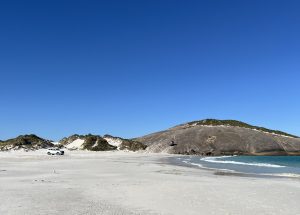 Last day in Esperance we got some more huffy puffy exercise walking along the beach of Wylie Bay to Wylie Head (1½ hours each way). At low tide you can walk via a spit to large climbable rocks that are partly submerged at other times of the day. Very nice, but the real entertainment was happening on the opposite side. 4WD cars attempting to ‘drive’ up the granite headland to the top. Some made it and there was lots of Whoop-ing, some didn’t, only to come down and try again. Must be one of the local ‘bragging rights’ challenges, crazy stuff.
Last day in Esperance we got some more huffy puffy exercise walking along the beach of Wylie Bay to Wylie Head (1½ hours each way). At low tide you can walk via a spit to large climbable rocks that are partly submerged at other times of the day. Very nice, but the real entertainment was happening on the opposite side. 4WD cars attempting to ‘drive’ up the granite headland to the top. Some made it and there was lots of Whoop-ing, some didn’t, only to come down and try again. Must be one of the local ‘bragging rights’ challenges, crazy stuff.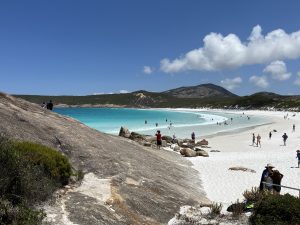


 We upped anchor at Reevesby Island and 10.5 hours later we were at Wardang Island. By this stage it was twilight so we decided to anchor here for the night. The next day we motored into Port Victoria and anchored north of the jetty. We plonked a couple of jerry cans in the dinghy and took off to have a look around and get some fuel. The main street extends from the jetty, with a combined general store/take away food shop/post office, pub, community hall and of specific interest to us a large tin shed with an old style bowser out front, directly on the kerb. Unlucky for us there wasn’t anyone around. So with jerry cans in hand we retraced our steps hoping to find a local that could give us some idea when the shed would be open for business. No luck there either. So we headed back towards the jetty, and decided to try our luck at the general store/take away shop.
We upped anchor at Reevesby Island and 10.5 hours later we were at Wardang Island. By this stage it was twilight so we decided to anchor here for the night. The next day we motored into Port Victoria and anchored north of the jetty. We plonked a couple of jerry cans in the dinghy and took off to have a look around and get some fuel. The main street extends from the jetty, with a combined general store/take away food shop/post office, pub, community hall and of specific interest to us a large tin shed with an old style bowser out front, directly on the kerb. Unlucky for us there wasn’t anyone around. So with jerry cans in hand we retraced our steps hoping to find a local that could give us some idea when the shed would be open for business. No luck there either. So we headed back towards the jetty, and decided to try our luck at the general store/take away shop. 



 It was just beautiful, and the name couldn’t be more fitting. Shaped like a wine glass, the entrance is quite narrow, which then opens up to a bay. There are a couple of moorings here, and we made use of the one in the middle and in the deeper part of the bay. Headed to shore, to check out the large fallen rock structures which were scattered throughout the beach. NB Snug Cove should be avoided in northerly winds, according to a local source boats have been beached here in the past.
It was just beautiful, and the name couldn’t be more fitting. Shaped like a wine glass, the entrance is quite narrow, which then opens up to a bay. There are a couple of moorings here, and we made use of the one in the middle and in the deeper part of the bay. Headed to shore, to check out the large fallen rock structures which were scattered throughout the beach. NB Snug Cove should be avoided in northerly winds, according to a local source boats have been beached here in the past.